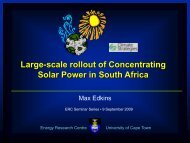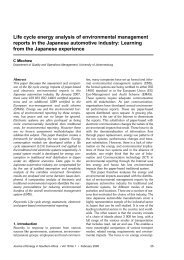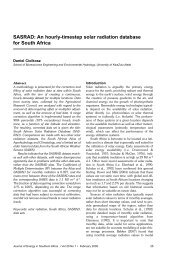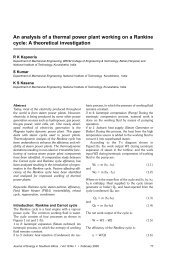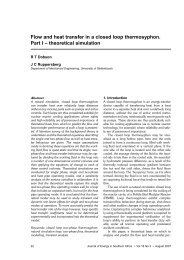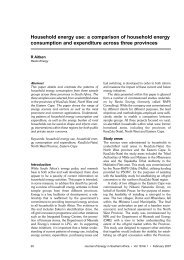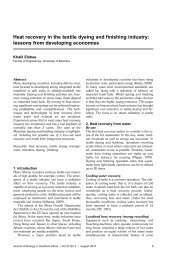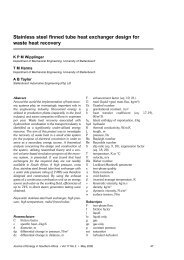Solar electrification by the concession approach in rural Limpopo ...
Solar electrification by the concession approach in rural Limpopo ...
Solar electrification by the concession approach in rural Limpopo ...
Create successful ePaper yourself
Turn your PDF publications into a flip-book with our unique Google optimized e-Paper software.
<strong>Solar</strong> <strong>electrification</strong> <strong>by</strong> <strong>the</strong> <strong>concession</strong> <strong>approach</strong> <strong>in</strong> <strong>rural</strong> <strong>Limpopo</strong> prov<strong>in</strong>ce 37<strong>the</strong> time of <strong>the</strong> survey. Of course without know<strong>in</strong>g for how long <strong>the</strong>se systems had been unattended,it is not possible to say whe<strong>the</strong>r this represents a ma<strong>in</strong>tenance problem; <strong>the</strong> survey was a snapshot ofan ongo<strong>in</strong>g project and it can be reasonably expected that some systems await<strong>in</strong>g repairs would beencountered.Most SHS owners seem to be unaware that grid-users face a similar dilemma <strong>in</strong> that <strong>the</strong> cost of gridelectricity precluded some 80% of <strong>the</strong>m from us<strong>in</strong>g electricity for cook<strong>in</strong>g.11.5 Problems with <strong>the</strong> SHSsAbout 40% of SHS-users had experienced a problem with <strong>the</strong>ir systems. A similar percentage (37%)felt <strong>the</strong>y were able to identify <strong>the</strong> problem and virtually all had reported <strong>the</strong> problems. The reportswere generally made to <strong>the</strong> energy store, but a few respondents reported to <strong>the</strong> chief, <strong>the</strong> technician,and <strong>the</strong> fee collector. How reliably or promptly <strong>the</strong>se reports reached <strong>the</strong> service provider is notclear. 16% of <strong>the</strong> problems were unresolved at <strong>the</strong> time of <strong>the</strong> survey, but it is not possible to say forhow long <strong>the</strong> problems had been outstand<strong>in</strong>g.The most frequently mentioned problem was low battery voltage. This is generally a symptom thatarises from many causes like loose connections, faulty charge controller, battery com<strong>in</strong>g to <strong>the</strong> endof its useful life, misuse of <strong>the</strong> system, or prolonged cloudy wea<strong>the</strong>r. The problem as reported can<strong>the</strong>refore not directly assist <strong>in</strong> diagnos<strong>in</strong>g what may be wrong with <strong>the</strong> systems.SHS-users pay much more than <strong>the</strong> o<strong>the</strong>r sub-samples and <strong>the</strong>y were frustrated <strong>by</strong> this high cost.Their ma<strong>in</strong> suggestion for mak<strong>in</strong>g payment easier was to reduce <strong>the</strong> service fee. Ano<strong>the</strong>r majorconcern was <strong>the</strong> limitation <strong>in</strong> both what can be used with SHS, <strong>the</strong> number of rooms that could besupplied with power, and <strong>the</strong> time limitation on power availability. The need to purchase o<strong>the</strong>r fuelsadds to <strong>the</strong> cost of energy for SHS households.11.6 Cost, limited power and <strong>the</strong> cost of o<strong>the</strong>r necessary fuelsSHS users pay much more per month than <strong>the</strong> o<strong>the</strong>r sub-samples for <strong>the</strong>ir energy (R128) – more thantwice as much as grid-users (R59) who <strong>in</strong> fact pay <strong>the</strong> least among <strong>the</strong> three sub-samples. SHS-usersare <strong>the</strong> only sub-sample with a mean monthly expenditure on energy that is above <strong>the</strong> overall meanof R93. The service level received <strong>by</strong> grid users is practically unlimited for household level needs.SHS-users have to spend an additional R70 for o<strong>the</strong>r fuels on top of <strong>the</strong> R58 paid for <strong>the</strong> SHS eachmonth. 68% of <strong>the</strong>m thought <strong>the</strong>y should be pay<strong>in</strong>g no more than R30 per month for <strong>the</strong> service,which seems fair and would be comparable to what grid users pay on average for <strong>the</strong>ir electricity.Non-electrified households show <strong>the</strong> highest mean monthly expenditure on fuelwood while solarhome system-users have <strong>the</strong> highest mean expenditure on gas. Grid-users do not use gas, and spendlittle on o<strong>the</strong>r fuels except for fuelwood. Grid electricity is <strong>the</strong>ir second major fuel expenditure item.Because solar home system-users had on average 4.6 rooms per homestead, <strong>the</strong> three <strong>in</strong>side lightsprovided with <strong>the</strong> solar home systems were <strong>in</strong>sufficient to light all rooms. Light<strong>in</strong>g times varied <strong>by</strong>roughly one hour between summer and w<strong>in</strong>ter. Lights were generally switched on 40 m<strong>in</strong>utes to onehour after sunset, which is to be expected given that <strong>the</strong>re is about half an hour of twilight aftersunset. Switch-off time was not very different between grid-users and SHS-users, suggest<strong>in</strong>g thatbedtime was due more to habit than <strong>by</strong> electricity source characteristics.The awareness of <strong>the</strong> need to conserve electricity was greater among solar home system-users, 97%of whom switched off lights <strong>in</strong> unoccupied rooms compared to 56% among grid-users. Switch<strong>in</strong>g offlights while watch<strong>in</strong>g television was common, largely to save electricity <strong>by</strong> SHS-users (20%) and tosee <strong>the</strong> image better among grid-users (13%). The activities for which electric light<strong>in</strong>g was useddiffer <strong>in</strong> that grid-users cite ‘socialise/rest’ and household chores as <strong>the</strong>ir ma<strong>in</strong> uses far more thansolar home system-users, and add ‘crafts/work’, and ‘bath/prepare for work’ which are notmentioned <strong>by</strong> solar home system-users The ‘crafts/work’ activities are <strong>in</strong>terest<strong>in</strong>g because <strong>the</strong>ysuggest a possible productive use. <strong>Solar</strong> home system-users <strong>in</strong>dicated television/radio andhomework/study as <strong>the</strong>ir ma<strong>in</strong> uses for electric light<strong>in</strong>g.Far more grid-users (76%) felt that outside lights had enhanced security than SHS-users (44%),probably because <strong>the</strong> former could regularly leave <strong>the</strong>ir outside lights on all night; someth<strong>in</strong>g solarhome system-users could not do without risk<strong>in</strong>g automatic low voltage cut-offs.ENERGY RESEARCH CENTRE




